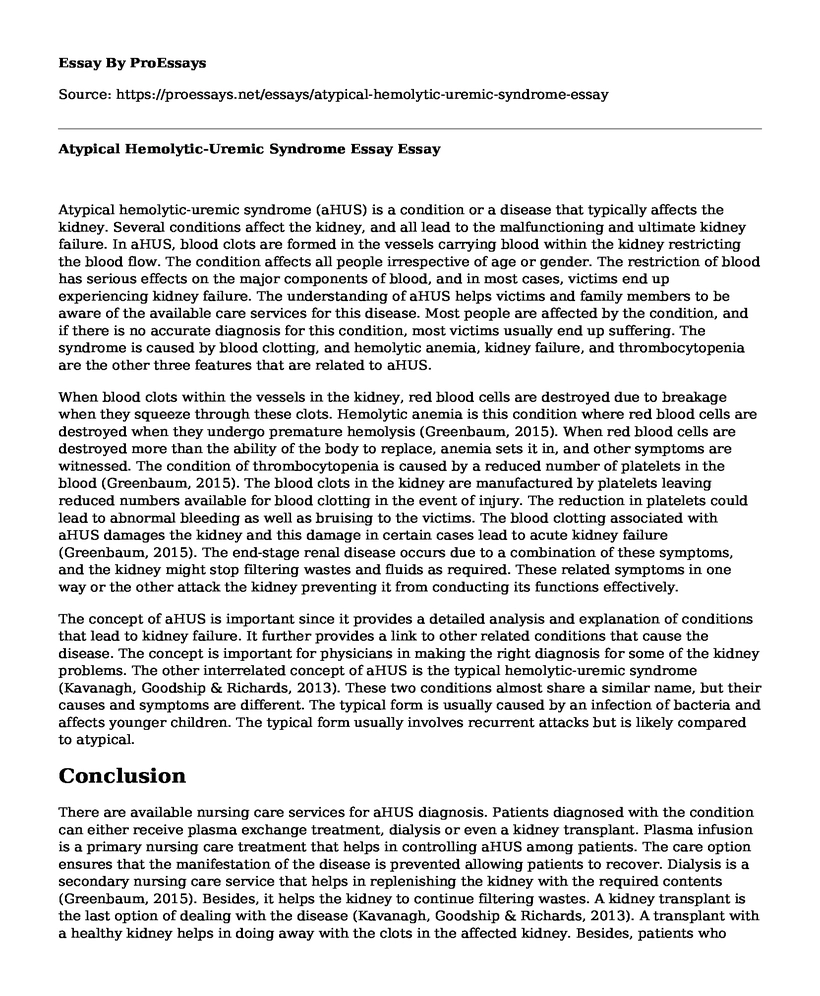Atypical hemolytic-uremic syndrome (aHUS) is a condition or a disease that typically affects the kidney. Several conditions affect the kidney, and all lead to the malfunctioning and ultimate kidney failure. In aHUS, blood clots are formed in the vessels carrying blood within the kidney restricting the blood flow. The condition affects all people irrespective of age or gender. The restriction of blood has serious effects on the major components of blood, and in most cases, victims end up experiencing kidney failure. The understanding of aHUS helps victims and family members to be aware of the available care services for this disease. Most people are affected by the condition, and if there is no accurate diagnosis for this condition, most victims usually end up suffering. The syndrome is caused by blood clotting, and hemolytic anemia, kidney failure, and thrombocytopenia are the other three features that are related to aHUS.
When blood clots within the vessels in the kidney, red blood cells are destroyed due to breakage when they squeeze through these clots. Hemolytic anemia is this condition where red blood cells are destroyed when they undergo premature hemolysis (Greenbaum, 2015). When red blood cells are destroyed more than the ability of the body to replace, anemia sets it in, and other symptoms are witnessed. The condition of thrombocytopenia is caused by a reduced number of platelets in the blood (Greenbaum, 2015). The blood clots in the kidney are manufactured by platelets leaving reduced numbers available for blood clotting in the event of injury. The reduction in platelets could lead to abnormal bleeding as well as bruising to the victims. The blood clotting associated with aHUS damages the kidney and this damage in certain cases lead to acute kidney failure (Greenbaum, 2015). The end-stage renal disease occurs due to a combination of these symptoms, and the kidney might stop filtering wastes and fluids as required. These related symptoms in one way or the other attack the kidney preventing it from conducting its functions effectively.
The concept of aHUS is important since it provides a detailed analysis and explanation of conditions that lead to kidney failure. It further provides a link to other related conditions that cause the disease. The concept is important for physicians in making the right diagnosis for some of the kidney problems. The other interrelated concept of aHUS is the typical hemolytic-uremic syndrome (Kavanagh, Goodship & Richards, 2013). These two conditions almost share a similar name, but their causes and symptoms are different. The typical form is usually caused by an infection of bacteria and affects younger children. The typical form usually involves recurrent attacks but is likely compared to atypical.
Conclusion
There are available nursing care services for aHUS diagnosis. Patients diagnosed with the condition can either receive plasma exchange treatment, dialysis or even a kidney transplant. Plasma infusion is a primary nursing care treatment that helps in controlling aHUS among patients. The care option ensures that the manifestation of the disease is prevented allowing patients to recover. Dialysis is a secondary nursing care service that helps in replenishing the kidney with the required contents (Greenbaum, 2015). Besides, it helps the kidney to continue filtering wastes. A kidney transplant is the last option of dealing with the disease (Kavanagh, Goodship & Richards, 2013). A transplant with a healthy kidney helps in doing away with the clots in the affected kidney. Besides, patients who receive the transplant with revert back to their normal lives with limited or no complications.
References
Greenbaum, L. A. (2015). Atypical hemolytic uremic syndrome. Advances in Pediatrics, E-Book, 61, 335-356.
Kavanagh, D., Goodship, T. H., & Richards, A. (2013, November). Atypical hemolytic uremic syndrome. In Seminars in nephrology (Vol. 33, No. 6, pp. 508-530). WB Saunders.
Cite this page
Atypical Hemolytic-Uremic Syndrome Essay. (2022, Aug 08). Retrieved from https://proessays.net/essays/atypical-hemolytic-uremic-syndrome-essay
If you are the original author of this essay and no longer wish to have it published on the ProEssays website, please click below to request its removal:
- Fetal Alcohol Spectrum Disorder
- Social Constructivism Paper Example
- Single Audit Report-State of New Jersey
- Paper Example on Nurse Practitioners Prescribing Narcotics: A Review of Benefits
- Essay on Pro-abortionists and Anti-abortionists
- Nurses: Challenges, Opportunities and Advocacy - Research Paper
- Essay on Grieving the Loss of an Unborn Child: A Heartbreaking Reality for Parents







